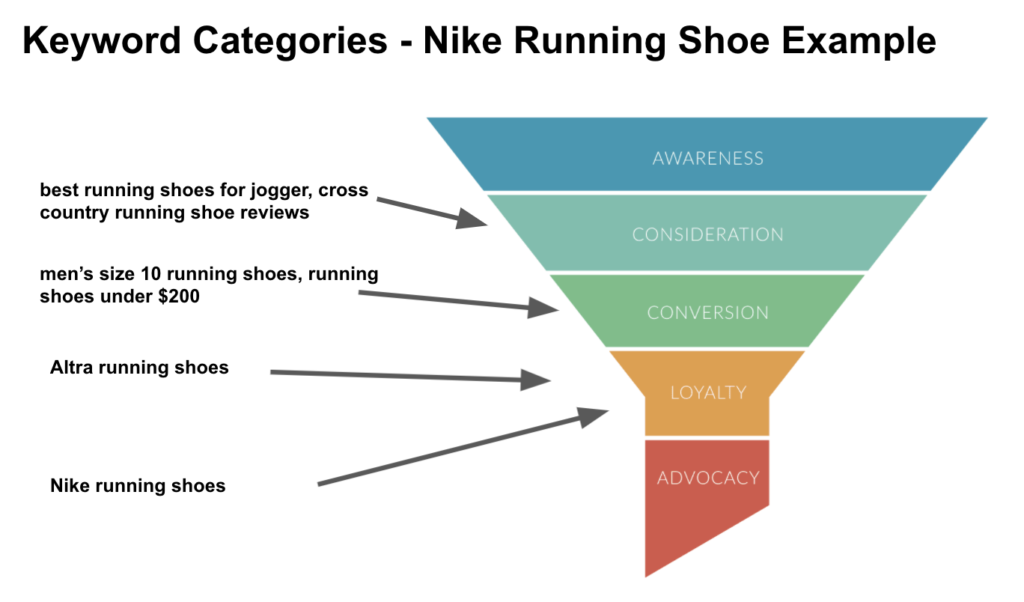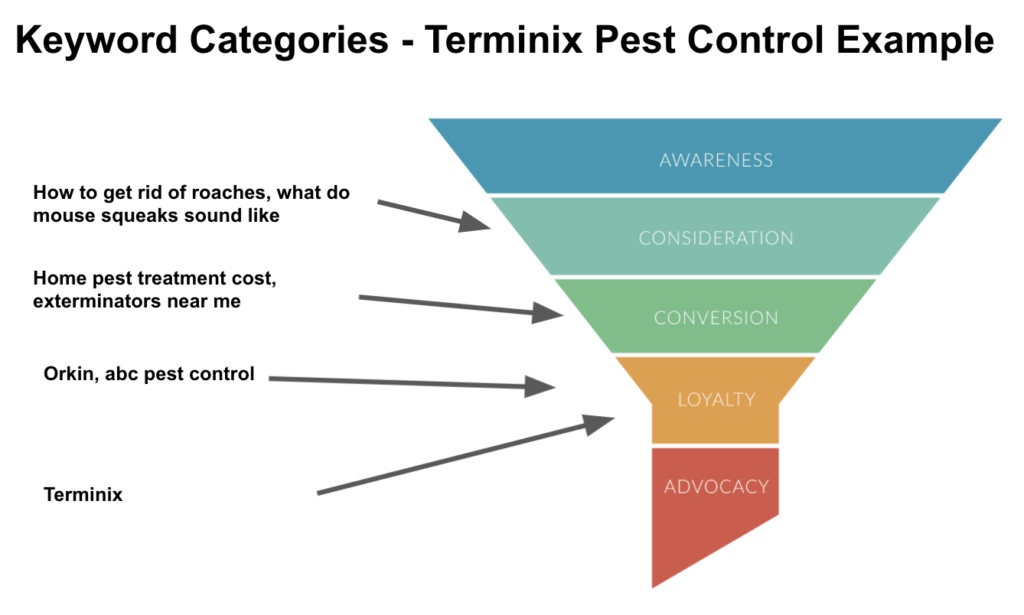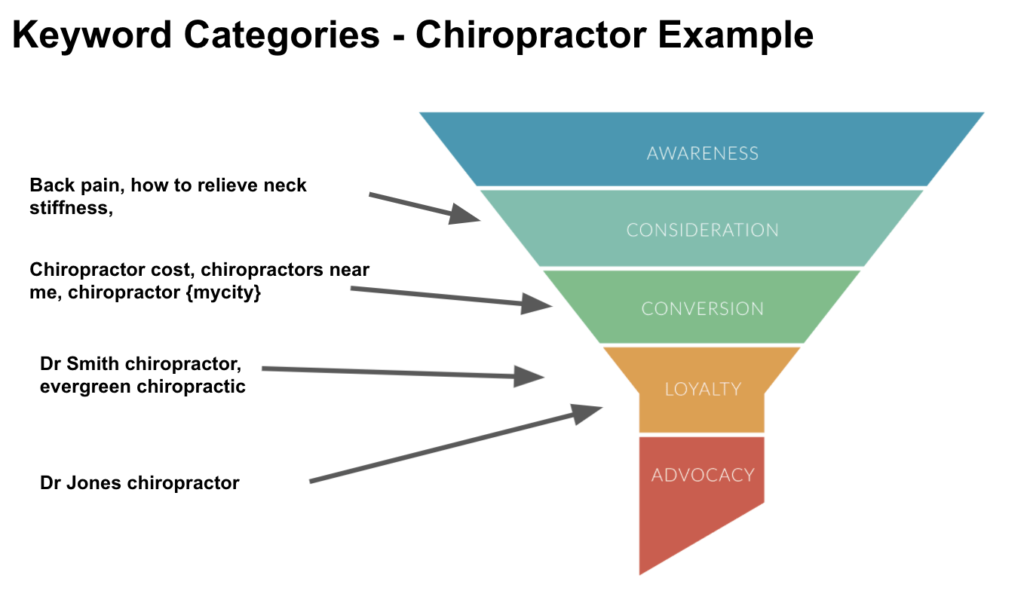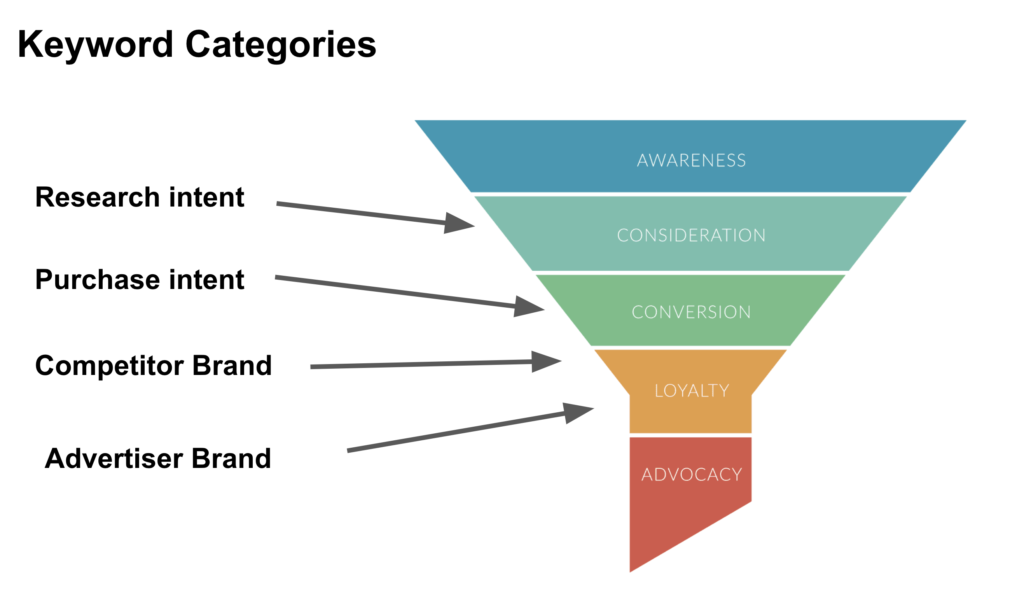Segmenting Keywords by Consumer Intent
Keywords are a foundational element of paid search advertising. We’ve previously discussed the differences between keywords and search queries in some depth so we’ll omit that here. Today we’ll be focusing on identifying the different types of keywords which will help you influence customers who are searching on Google. We’ll look at 4 key traffic types, where they live in the customer journey and briefly discuss some strategies and tactics that we like to implement to get more customers from each type of query.
Categories and Customer Journey Step
Keywords could be broken down into categories in dozens of different ways. We aren’t saying our way is better than any other, but we find it useful. Our general keyword categories are:
- Research intent category/product
- Purchase/shopping intent
- Competitor brand name
- Advertiser brand name
Research Intent – Paid Search Keywords
Research intent keywords can be identified fairly easily. If you think about any purchase (car, home, dandruff shampoo…) you can come up with some initial questions that a potential customer might have. We know in 2021 if we have a question, we google it, so that’s what our customers are doing. The conversion rates for this traffic will be lower than the categories we’ll discuss soon. The reason for this is that the customer often hasn’t even decided for sure what the problem is. Therefore, they also are not yet ready to pay for a solution.
To account for this, we adopt a different strategy for these customers than we could for customers who are more ready to buy. Instead of driving the customer to a “request info from sales” or ecommerce transaction type conversion, we see better results with “enter email to get product education” calls to action. By understanding the intent of the customer, we collect their email address, maybe add them to a remarking audience, and keep our brand top of mind as they move closer to a purchase.
A running shoe example can give us some context to think about research intent compared to other google ads keyword categories.

Purchase Intent Keywords
There is a lot of variance in how purchase intent keywords will present. For many advertisers purchase intent will include cost or time modifiers. “emergency dentist” as opposed to “dentists” “roof replacement prices” instead of “roofing” “restaurants near me open late” instead of “restaurants {mycity}” For business to business advertisers these purchase intent signals could come in the form of part numbers. We’ve also seen situations where software brands demonstrate purchase intent. Usually these are business tools which are only well known within the tiny subset (even 100k people is a rounding error of a percentage of the googleverse) of the population that interacts with them.
Users who type in purchase intent keywords can be 2-8x more likely to “convert”. We generally measure ecommerce transactions, phone calls, form fills, and email newsletter signups as conversions. By measuring each accurately, and setting up a smart link to a CRM, we refine the estimated value of each conversion over time. These purchase intent keywords often become even more attractive over time as we learn more about how they impact customer lifetime value.
The get another view of purchase intent keywords let’s look at another example hypothesizing Terminx pest control as the client.

Competitor Brands & Conquesting
Brand intent traffic is pretty much always higher converting than category traffic. Whether this traffic is for your brand, or a competitor’s brand, people who want to buy what you sell are searching on these terms. Google Ads demonstrates a deep knowledge of this by how it serves ads for broad match keywords. Unless your PPC manager actively works to block competitor brand traffic from your category keyword campaigns, google will serve a customer who searches for “nike” your ad for that you intended to serve when someone searches “running shoes”. At first, this might seem like Google doing you a disservice, but they’re actually doing most advertisers a favor.
Customers who search brand names as keywords, especially lesser known brands, have a significantly higher propensity to buy right now than those who search for products. This might have to do with these customers already understanding the product/use case, having previously purchased a similar product, or other issues, but we’ve seen this hold true across millions of dollars in paid search spend. A tactic that most advertisers should consider is actively targeting their competitors’ brand keywords.
One could think of these competitor brand keywords in further segmentations such as direct competitors, substitutes, wholesale/retail and others. An example as a local chiropractic office.

Why are these categories important?
By creating Google Ads campaigns which target users in a specific google ads keyword category, we give ourselves several important levers. We can now dictate daily spend, subject to search volume. This means that even if your overall monthly budget is limited, you can shift your budget toward the most profitable traffic categories. This would be a “harvest” type strategy, most appropriate when you want to maximize shorter term profitability.
Before we dive deeper, I need to mention that most google ads accounts are not structured in a way which would allow the advertiser to take advantage of these categories. Often brand keywords and product keywords are mixed into the same campaigns. Even accounts which create these campaign/keyword segments often mix traffic. If you
Let’s explore this with a hypothetical. Let’s imagine these numbers for a local plumbing business using a 30 day date range
| Campaign | Budget | Cost | Impressions Share (IS) | Lost IS to Budget |
| Search – Brand | $20/day | $608 | 65% | 50% |
| Search – Conquest | $50/day | $1,528 | 30% | 65% |
| Search – Product/Service | $200/day | $5,964 | 15% | 75% |
In this example all three categories are spending the full, or very close to the full budget each day. That’s why we see significant lost impression share (IS) for all three categories.
| Campaign | Budget | Cost | Impressions Share (IS) | Lost IS to Budget |
| Search – Brand | $60/day | $1,127 | 90% | 0% |
| Search – Conquest | $110/day | $3,250 | 60% | 20% |
| Search – Product/Service | $100/day | $3,030 | <10% | 80% |
So on this same, $7,000ish monthly budget we would significantly increase impression share for both advertiser brand and competitor brand terms. Given that these are likely the best converting terms, this will give us a competitive edge over advertisers who use the much more common and easy to set up mixed strategy. We would also be extremely likely see a big reduction in cost per lead.
With this increased efficiency many clients can scale up sales and delivery. By refining each step in the process on this more relevant traffic, we can build a digital sales funnel that will be more profitable than average for the higher funnel product/service keywords as well.
Advantages of Keyword Segmentation using Brand, Conquest, Product Mindset
As we’ve outlined, the strategy of separating your paid search keywords into brand, conquest, and product categories include:
- Optimized Cost Per Lead
- Customer Intent Level Budget Control
- Improved Revenue Attribution Accuracy
We don’t claim to be the only agency in the world that follows this type of formula. We do claim to follow the formula well. If you’re a brand that knows it should be having more success with Google Ads than you currently are, we might be able to help. Request a call to learn more about our strategies and explore a fit as a client.



